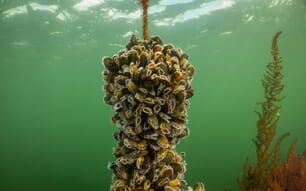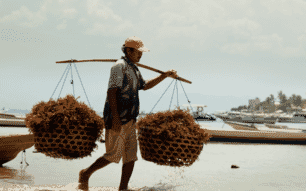Applications for more than 1,000 acres of oyster and kelp farms were filed with the Department of Natural Resources by the April 30 deadline, far more than usual. Fifteen are for new farms in the Southeast, Southcentral and Westward regions of which seven plan to grow kelp exclusively. Two farms at Klawok also are adding kelp to their current oyster growing operations.
“These permit applications are an indicator that there is developing interest and growth in the mariculture industry in Alaska,” said Linda Mattson, from the Department of Commerce, Community and Economic Development (DCCED), upon announcing the numbers.
Along with other state agencies, DCCED is an active part of the 11 member Alaska Mariculture Task Force established by an Administrative Order in 2016. The group’s mission is to provide Governor Walker with a comprehensive report for statewide mariculture expansion by March 1 of next year. Walker believes mariculture of shellfish and seaweeds is a viable means to diversify the economy and provide a $1 billion economy within 30 years.
“The timing is right,” said task force co-chair Julie Decker of Wrangell. “It’s exciting that many of the applicants are young Alaska fishermen who are planning to have kelp be an adjunct to help diversify their fishing portfolio. Plus, shellfish are filter feeders and clean the waters and seaweed are a carbon sink and also produce really healthy products. I think we’re on a good path.”
For existing aquatic farmers who are growing shellfish, kelp can provide them with a ready cash flow while they are waiting for up to three years for their bivalve crops to ripen.
“Kelp only take about 90 days to grow so you can stagger your plantings and lengthen your seasons,” Decker added.
Latest data from the Alaska Department of Fish and Game show that 54 aquatic farms, seven shellfish nurseries and two shellfish hatcheries are operating in Alaska, primarily growing Pacific oysters, with sales topping $1 million in 2014 and 2015. Production in 2015 of 10.6 million oysters fetched an average price of $9.84 per dozen, up $0.24 (2.5 percent) from 2014.
“If just three-tenths of a percent of Alaska’s 35,000 miles of coastline was developed for oysters,” Decker said, “it could produce 1.3 billion oysters at 80 cents, adding up to over $1 billion a year!”
For blue mussels, production in 2015 showed a 74 percent increase to 16,688 pounds with a value of $5.27 per pound (down $0.47 from 2014) for a total of $70,800.
In terms of the fledgling kelp industry, a first 15,000 pound harvest last month on a one acre plot at Kodiak owned by Nick and Stephanie Mangini paid out at roughly $10,000. Their business, Kodiak Island Sustainable Seaweed (KISS), plans to expand to 17 acres by next year.
Kings expected early in the Yukon
A warmer than average April could mean an early return of Chinook salmon again to the Yukon River and fish watchers are on alert for signs of the first pulse to arrive around June 10. While low numbers mean no commercial fishery again this year, the kings are crucial for subsistence users.
Even with 56 years of Yukon data, it’s a tough run to track because the timing is so unpredictable, said Phil Mundy, director of NOAA Fisheries’ Auke Bay lab in Juneau. Mundy has been studying Alaska salmon since the 1970s, but said it was Yukon elders who taught him how to fine-tune the run timing.
“They told me ‘the wind blows the fish in the river - everyone knows that, young man,’” he said, adding that Cook Inlet fishermen said the same thing about sockeye salmon.
“They said, ‘it’s when the wind blows and you get the biggest tide closest to July 17. Everyone knows that.’ But we couldn’t figure out exactly how. I didn’t think the fish put up their dorsal fin like a sail to blow into the river, but there had to be something because they seemed to be right,” Mundy mused.
“I used to count fish from airplanes, and I’ve seen at Cook Inlet and at Bristol Bay where you get the river water piling up against the marine water on the river plume,” he added. “Then you’ll see the salmon weaving in and out along the edge of the front between the fresh water and the salt water. I never knew why they were doing that. They will pile up if there is no wind to mix the fresh and salt water to make it brackish. They will pile up on that front until some other trigger, which we probably don’t understand, sends them all in.”
In 2006 Mundy saw a scientific article that focused on how salmon make the change from fresh to salt water and vice versa.
“There’s this thing called a calcium ion switch, and it is triggered by alternating exposure to different salinities,” he explained. “Young salmon can’t swim straight into salt water because it will kill them, and it’s the same for adults in the ocean returning to their home streams. They have to have alternating exposure to different salinities.”
At the Yukon, Mundy said the wind mixing the water even tops early ice melts as the best indicator of the salmon arrivals. Today, satellite readings from the Alaska Ocean Observing System make predictions easier and more reliable.


